Words: Paul Trimble
When James, the Editor of Bike Magic, asked if I wanted to take a look at and review some lights from USE, well, I said yes. You see what James was not aware of is that I am something of an LED nut. I have built my own lights in the past. I have used many various sets on the trails in my time and also built custom scientific kit using the most powerful LEDs available today. So I waited to see what would come and low and behold, it was USE’s new, top of the range, flagship light, the Reflex MK2.
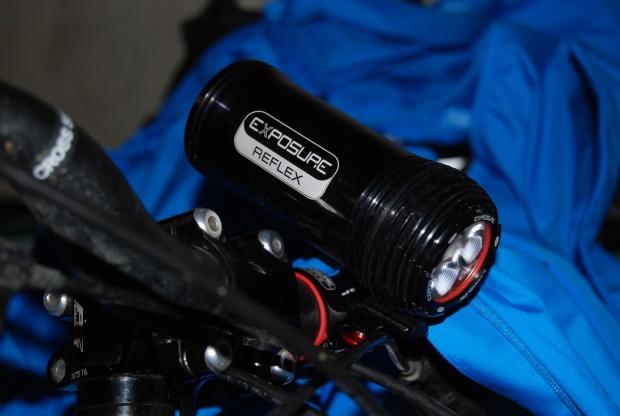
The Reflex
Now in many ways, having the best of the wide stable of lights that USE produce has made this a difficult product to review. When I first looked at it with all its bells and whistles, I thought it was over the top. However the thing about having something to review (and me being a bit chatty) is that it resulted in my showing this light to loads of people: from night riding trail warriors, to all-year commuters, to road riders with a fetish for ultra distances, and I made some interesting findings. Now I tend to feel that having the lower range of a product group can give you a lot of the benefits of the innovation, without always incurring all of the costs, but I had the Reflex… so what do you get for your money?
The light unit
Firstly a bit about USE: For anyone who doesn’t know, ‘USE’ stands for Ultimate Sport Engineering, and once you start to look at this light (and I have been doing a lot of looking) you keep noticing one thing, which is the quality.
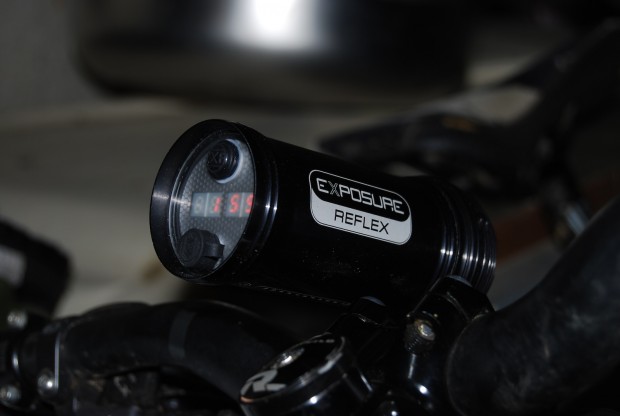
From the pre-formed case that the unit comes in to the beautifully simple and elegant bar clamp (which worked well on older skinny bars and also on standard sizes), to the actual light itself, the machining, the anodising, laser etching, it’s all excellent.
The lamp unit appears to be relatively weather tight, with a good weatherproof cap covering the only exposed port. This port acts as both a charger port and a “smart” port, allowing for accessories such as a bar mounted switch, and the ability to charge USB devices using the Reflex as the power supply. It is all clever stuff.
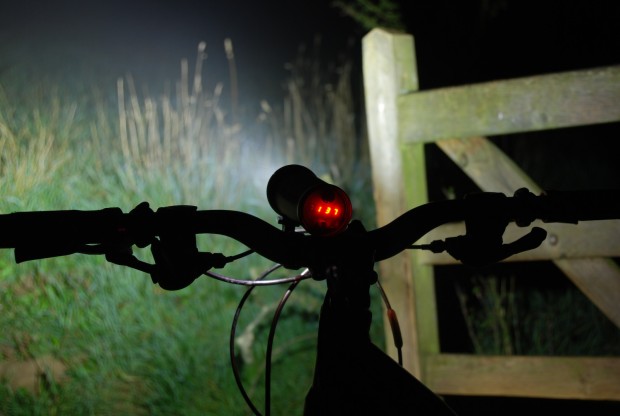
The rear of the light also has the “Fuel Gauge”. Now this is the bit of the light that for me really made me go ‘yes that’s good!’ It gives you the ability to see how much time your lights have left on their current setting, displayed in hours and minutes. The display also doubles up as a charge display, showing you the percentage of charge – useful info if you are just giving the light a quick charge before you go out. And as a show of how well these lights have been thought out, the display will flip itself automatically depending if the lights are on top, or under the bars (see “quality”). The fuel gauge really allowed me to manage my lights, and it was probably the feature of the light that I liked the most. The output from the lights is huge anyway so I found myself dropping the power and seeing the time increase it gives you. This gives you all sorts of ideas – why ride for two hours, why not four? Why not six? Hell, go all night and see in the dawn! And I have been doing a lot of riding. Certainly it has helped that for the month I have had the Reflex it’s been dry, but I have been out three or four times a week, and although I have not yet done an all-nighter, this is definitely the light to allow you to do it.
The light itself
So, the light. Well it’s supplied via three Cree XMLs, which (if you are not into your LEDs) are not cheap. They are quality ones (see it’s that word again) and they do give a really nice, clean light. The spread is wide and this is definitely a bars-only light. Talking of which, this is the first time that I have not had a separate battery pack. Certainly, the light itself is larger than those with battery packs, but I was not unduly bothered by the increased size once it was on the bars. The weight and size of the unit was not an issue for me and the lack of a cable was nice. The spread of the light is excellent and it still has a good penetration.
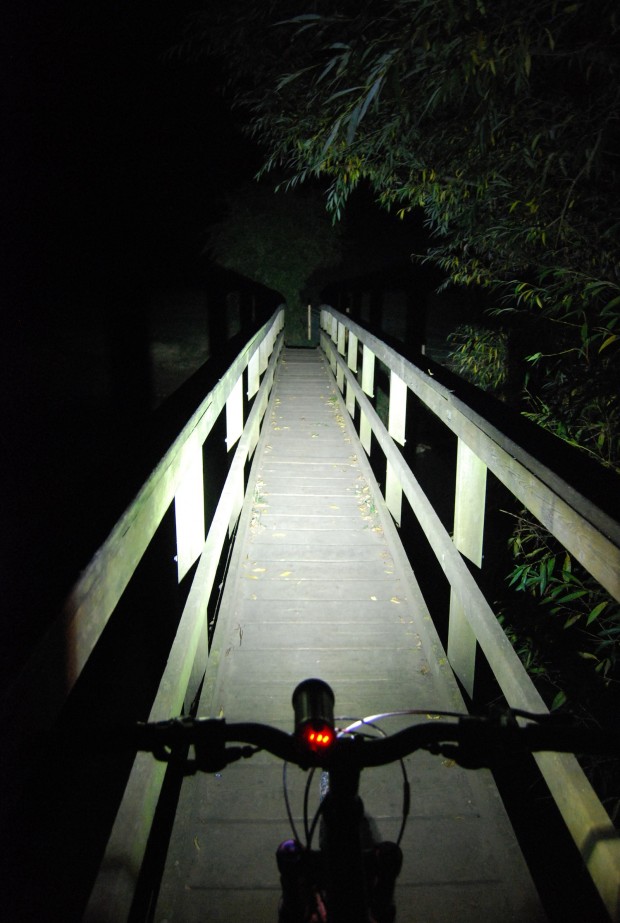
The Reflex also has 11 (yes 11) programmes. Now that’s a lot. But by chatting to people and showing them the light, this number of options actually made sense. The first three, with the A, utilises the Reflex’s party piece whereby the light has the ability to sense what you are riding, and in an effort to give you the most from your battery adjusts its output accordingly. Going downhill it gives you extra light, while on an uphill slog it conserves some of the battery and lowers the lumens. At first it is a bit strange, and was something that I particularly noticed on the climbs. On the descents the light is just really bright, but get to a climb and the light takes on the look of one with a failing battery. It goes really dim, and you think, “oh no”, but get to the flat and up it comes again back to its best. I tried the light on all three of the Reflex settings, and even on the lowest power (which gives you 12 hours) I found I was happily riding tracks and trails at a relaxed pace.
Settings 4 to 6 high, medium, low and flash. 7 to 9 high, medium, and flash. Now initially I thought this amount of choice was just plain silly, but again by passing the light around I was surprised. Some people want the three settings, and have chosen lights specifically because of that, others want just two settings and again have bought and paid more to have what they want.
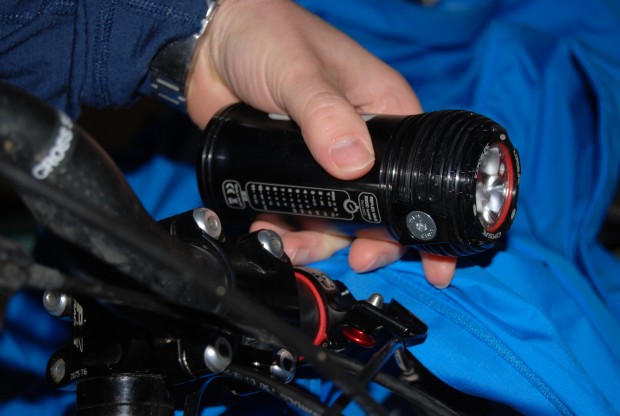
The last two: 10 and 11, are kind of the racer settings as I see them: ‘Boost’, ‘12 hours’ and ‘SOS’ (for when the darkest hours before the dawn have given you those hallucinations) or just 10 hours or 24 hours of light, (for when you brain has stopped working after 24 hours or you are doing the London – Edinburgh – London LEL Audax road ride). Luckily all these settings are etched in the base of the unit, and are accessed by pressing and holding the button, and then scrolling through on the display.
Which brings me nicely to the light levels. At top power this thing is giving out 2200 lumens (or REALLY, REALLY bright to Jo Public). It was certainly the brightest light on the group rides I got on, although only just. Unfortunately, although normally I would be happy to ride with just this light, I also do a fair amount of riding in the woods along tight, twisting Singletrack, and there I did find that I also needed a helmet light as no matter how bright the light is, it’s not much use if your bars are facing the wrong way!
The price
Now this is probably a good point to talk about the price, which is high and initially dominated how I thought about these lights. “One for the racers” kept springing to mind, and it’s true; if you race, or are a serious endurance rider then these lights are definitely for you. They could easily give you a winning advantage, and USE are well known here in the UK on that scene.
People kept saying, “I can buy a light from e-bay for 1/10th of the price” and that is also true, but cheap lights have cheap LEDs, cheap batteries and cheap electronics. Trust me, I have fixed my own on a number of occasions. You may get lots of rides out of them, and for a huge amount of social riders these lights are great. When they fail you can happily buy some more, but lights occupy a strange and unique part of the biker mentality. As with gear trains, people will happily pay huge amounts for XTR, even though SLX does the same basic job. Somehow people find it easy to justify XTR even when they do not race, similarly with suspension, carbon frames, carbon bars, the list is endless, yet for lots of people lights still go back to the bargain bin end of the spectrum, which is a shame.
I am not saying that £400 plus lights are for everyone, but think of it like this: lights are the only product that will give you more hours to be out on the trails. And look at it this way: if your lights are used for 40 weeks of the year (that’s just two rides a week and I certainly know people who do that week in, week out) that equates to just £5 a ride (or one and a half pints of ale at the pub afterwards).
Verdict
These are great lights. They are very well built, and more importantly a well thought-out product, suitable for every application a bike light can be used for, from high-speed trails to all-night races, this light will do it and do it well. Yes they are expensive, but you can easily spend the same money on indoor rollers or turbo trainers and I know which I would prefer.
Price: £434.95
More information: USE Exposure Reflex MK2 lights





